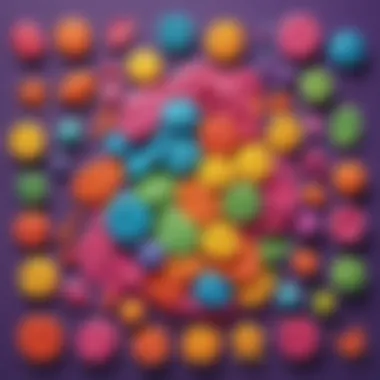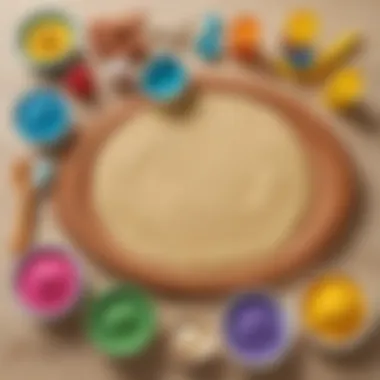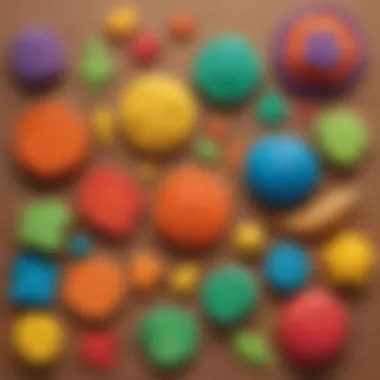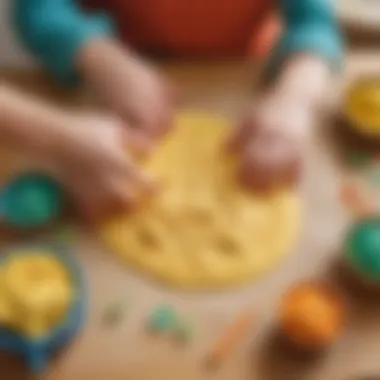Create Playdough at Home: A Fun & Educational Recipe for Young Scientists


Science Fun Facts
At the core of creating playdough at home lies a fascinating world of science waiting to be uncovered. Did you know that the consistency of playdough can be altered by adjusting the amount of salt in the recipe? This simple compound offers a canvas for young minds to experiment and learn about the properties of materials. Additionally, the vibrant colors in playdough can spark discussions on color mixing and the basics of chromatography, introducing children to concepts of chemistry in a fun and approachable manner.
Discover the Wonders of Science
As we delve deeper into the process of making playdough, we encounter a myriad of scientific concepts. From exploring the principles of texture and viscosity to understanding the role of heat in transforming ingredients, every step in this recipe unfolds a mini science lesson for little learners. Educational videos and animations can further supplement this hands-on activity, providing visual reinforcement of key scientific principles while igniting curiosity and a thirst for knowledge in children.
Science Experiment Showcase
The creation of playdough is, in essence, a science experiment in itself. By combining simple household ingredients like flour, salt, water, oil, and food coloring, children get to witness how individual components interact to form a new substance with unique properties. This hands-on experience not only cultivates a love for experimentation but also teaches valuable lessons in following instructions, measuring ingredients accurately, and practicing patience in observing chemical reactions. Safety tips and precautions are essential reminders to ensure a safe and enjoyable scientific exploration at home.
Introduction
As we embark on the exciting journey of creating playdough at home, we delve into a world where imagination and science converge to offer young minds a delightful blend of fun and education. The significance of this endeavor lies in its capacity to foster critical skills in children, nurturing their creativity, sensory development, and hands-on learning abilities. By immersing children in the process of making playdough from scratch, we provide them with a tangible medium through which they can explore and express their scientific curiosity.
Understanding the Benefits of Making Playdough at Home
Enhancing sensory development
The act of creating playdough at home serves as a sensory feast for young learners. Engaging in tactile experiences such as mixing the ingredients, feeling the textures, and experimenting with colors stimulates their sensory receptors, enhancing their tactile awareness and fine motor skills. This multisensory approach not only amplifies the pleasure of play but also aids in cognitive development by fostering the connection between sensory input and creative output.
Fostering creativity and imagination
Homemade playdough acts as a versatile medium for young imaginations to run wild. By sculpting, molding, and shaping their own creations, children are encouraged to think outside the box, explore unconventional ideas, and bring their colorful visions to life. This creative freedom not only boosts self-expression but also nurtures problem-solving skills as children navigate the endless possibilities that playdough presents.
Encouraging hands-on learning
The hands-on nature of making playdough from scratch cultivates a rich learning experience for children. From measuring the ingredients to kneading the dough, every step fosters a sense of accomplishment and personal involvement. This interactive process instills valuable lessons in patience, perseverance, and attention to detail, laying a strong foundation for future scientific inquiry and experimentation.


Overview of the Ingredients Required
Flour
Flour serves as the backbone of homemade playdough, providing the necessary bulk and consistency for shaping and molding. Its fine texture and binding properties make it an ideal choice for creating a pliable dough that can be transformed into various forms and structures. While flour may seem like a humble ingredient, its role in playdough production is crucial, offering a solid foundation for imaginative play.
Salt
Salt acts not only as a flavor enhancer in cooking but also as a key component in playdough recipes. Its presence helps strengthen the playdough structure, allowing it to hold shape and form over time. Additionally, salt plays a role in preserving the playdough, extending its lifespan for continued enjoyment. Despite its simple nature, salt plays a vital role in creating playdough that is both durable and malleable.
Cream of tartar
Cream of tartar serves as a natural stabilizer in playdough recipes, preventing crystallization and maintaining the dough's elasticity. This ingredient contributes to the smooth texture and pliable consistency of playdough, ensuring that it remains soft and supple during play. While often overlooked, cream of tartar is instrumental in creating playdough with the perfect balance of stretch and resilience, enhancing the overall tactile experience for young creators.
Water
Water acts as the essential liquid component in playdough, binding the dry ingredients together to form a cohesive mixture. Its role is to hydrate the flour and activate the binding properties of salt and cream of tartar, resulting in a moldable dough that is both smooth and resilient. The precise amount of water added determines the playdough's final texture, making it a critical element in achieving the desired consistency for optimal play.
Vegetable oil
Vegetable oil serves as a lubricating agent in playdough recipes, preventing the dough from sticking to surfaces and hands during play. Its slick nature adds a silky smoothness to the playdough, making it easier to knead, shape, and mold without leaving residue. While vegetable oil may seem like a minor ingredient, its impact on the playdough's workability and user experience is significant, ensuring a seamless and enjoyable creative process for young learners.
Step-by-Step Guide to Making Playdough
Crafting playdough at home serves as a fantastic activity that blends fun with education, catering to the inquisitive minds of budding scientists. This segment aims to offer a detailed breakdown of each crucial step involved in making playdough, ensuring a seamless and enriching experience for all little Science aficionados. By following these instructions diligently, parents, teachers, and caregivers can stimulate creativity and exploration in children, all while fostering a hands-on learning environment.
Mixing Dry Ingredients
A pivotal phase in the playdough-making process involves combining essential dry components like flour, salt, and cream of tartar. This amalgamation forms the base of the playdough, contributing to its texture, pliability, and durability. The utilization of flour provides the necessary structure, while salt acts as a preservative, extending the longevity of the playdough. Cream of tartar, renowned for its acidic properties, lends elasticity to the mixture, enabling smoother consistency and enhanced malleability. Altogether, these ingredients synergize to produce playdough that is both sensory-stimulating and long-lasting.
Adding Wet Ingredients


Introducing water and vegetable oil to the dry mixture marks a significant progression in the playdough-making journey. Water serves as a binding agent, facilitating the cohesion of the ingredients and the formation of a doughy mass. Vegetable oil plays a dual role, enhancing the playdough's smoothness and preventing it from becoming excessively sticky. This combination of wet ingredients not only binds the components together but also sets the stage for the subsequent stages of stirring and kneading, crucial for achieving the desired consistency and characteristics of the playdough.
Stirring and Kneading the Dough
The transition from mixing to stirring and kneading is vital for refining the playdough's texture and ensuring uniform distribution of ingredients. Stirring the amalgamated mixture until a cohesive dough forms is a meticulous process that demands patience and precision. Kneading the dough thereafter is an essential step that promotes smoothness and pliability, allowing for effortless shaping and molding. These meticulous actions guarantee that the playdough attains the desired elasticity and tactile appeal, setting the stage for creative exploration and imaginative play.
Enhancing Playdough with Colors and Scents
Elevating the sensory experience, incorporating food coloring introduces vibrant hues that stimulate visual perception and artistic expression in children. The versatility of colors enables endless possibilities for creating diverse shapes and forms, fostering imaginative play and artistic experimentation. Additionally, the infusion of essential oils imbues the playdough with enticing fragrances, enhancing the multisensory experience and adding a delightful olfactory dimension to the tactile exploration. By enlivening the playdough with colors and scents, children are encouraged to engage more deeply in creative endeavors, broadening their sensory horizons and fostering a holistic play experience.
Engaging Activities with Homemade Playdough
In the section of engaging activities with homemade playdough, we delve into the realm of tactile exploration and creative expression that captivates the minds of young learners. By offering a hands-on experience, homemade playdough serves as a versatile medium for endless imaginative play and educational opportunities. Through structured activities or free play, children can enhance their sensory perception, refine motor skills, and unleash their artistic inclinations with the pliable playdough at their fingertips.
Sensory Play and Exploration
Texture exploration
Texture exploration within the realm of homemade playdough provides a multisensory experience that stimulates not only the sense of touch but also enhances cognitive development. By manipulating playdough of varying consistencies - from smooth to grainy textures - children engage in sensory-rich activities that encourage sensory processing and fine motor skill refinement. The malleable nature of playdough allows young learners to explore different textures and shapes, fostering an understanding of tactile differences that are crucial for sensory integration.
Scented playdough activities
Incorporating scents into playdough activities introduces an olfactory dimension that elevates the sensory experience for children. Scented playdough activities not only engage the sense of smell but also promote cognitive connections through aroma recognition. By associating scents with colors or shapes, children engage in multisensory learning experiences that enhance memory retention and sensory processing. The addition of scents like vanilla, lavender, or citrus not only adds a pleasant aroma but also provides a sensory-rich environment for exploration and creative play.
Educational Games and Learning Opportunities
Mathematical concepts through playdough
Utilizing playdough as a tool for exploring mathematical concepts offers a hands-on approach to abstract ideas, making learning interactive and engaging for young minds. From basic counting and sorting activities to more advanced concepts like geometry and spatial reasoning, playdough serves as a versatile medium for mathematical exploration. By shaping and manipulating playdough into various forms, children develop a concrete understanding of mathematical principles such as shapes, fractions, and measurements in a tactile and playful manner.


Letter and shape recognition
Enhancing letter and shape recognition skills through playdough activities combines learning with creative expression, making the educational process dynamic and enjoyable. By molding playdough into letters, numbers, or geometric shapes, children engage in kinesthetic learning that reinforces visual identification and spatial awareness. The hands-on manipulation of playdough promotes hand-eye coordination and fine motor development, laying a foundation for literacy skills and geometric understanding in a captivating and interactive manner.
Creative Art Projects with Playdough
Sculpting animals and shapes
Sculpting animals and shapes with playdough encourages children to explore their creativity and hone their fine motor skills through imaginative sculpting. By molding playdough into familiar animals, objects, or abstract designs, young artists develop spatial reasoning and artistic expression. The pliable nature of playdough allows for experimentation and refinement, empowering children to bring their artistic visions to life in a three-dimensional form.
Creating miniature worlds
Engaging in the creation of miniature worlds with playdough offers children a canvas for storytelling, world-building, and imaginative play. By sculpting landscapes, characters, and props with playdough, young creators embark on a journey of creativity and narrative development. Building miniature worlds fosters storytelling skills, spatial awareness, and creative thinking as children bring their imaginary realms to life through sculpted creations that reflect their unique perspectives and imaginative storytelling.
Conclusion
Creating playdough at home is not just a playful activity but a valuable educational experience for children, especially young Science enthusiasts. By engaging in the process of making playdough, kids can enhance their sensory development, foster creativity and imagination, and promote hands-on learning. This hands-on approach allows children to explore different textures, experiment with colors and scents, and even learn basic mathematical concepts through playdough manipulation. The benefits of creating playdough at home go beyond mere entertainment; they pave the way for a holistic learning environment that nurtures a child's mind and creativity.
Summary of the Learning Experience
Reiterating the benefits of homemade playdough
Reiterating the benefits of homemade playdough underscores the significance of this hands-on activity in promoting cognitive development and creative expression among children. Homemade playdough offers a safe and customizable medium for sensory exploration, encouraging kids to engage their senses and imagination. Its non-toxic nature ensures that children can freely express themselves without concerns about harmful chemicals. The versatility of homemade playdough allows for endless possibilities in sculpting, molding, and shaping, enhancing fine motor skills and spatial awareness.
Encouraging continuous exploration and creativity
Encouraging continuous exploration and creativity instills a sense of curiosity and a love for learning in children. By engaging in imaginative play with playdough, kids can experiment, make mistakes, and innovate, fostering a growth mindset and resilience. Continuous exploration with playdough encourages children to think outside the box, develop problem-solving skills, and learn from their experiences. This active engagement with the material promotes persistence, patience, and a sense of accomplishment in young learners.
Final Thoughts and Encouragement
Inspire children to continue learning through play
Inspiring children to continue learning through play is a powerful way to nurture their natural curiosity and enthusiasm for discovery. Playdough provides a hands-on, sensory-rich experience that sparks creativity, encourages experimentation, and promotes a love for learning. By incorporating playdough into their playtime, children can develop a multitude of skills, from fine motor coordination to social-emotional development, in a fun and engaging manner.
Highlight the joy of hands-on experimentation
Highlighting the joy of hands-on experimentation encourages children to embrace the process of discovery and exploration. Hands-on experimentation with playdough allows children to express themselves artistically, engage in sensory play, and manipulate materials to bring their ideas to life. This process-oriented approach emphasizes the value of creativity, experimentation, and play in a child's overall development, instilling a sense of wonder and excitement in their learning journey.







